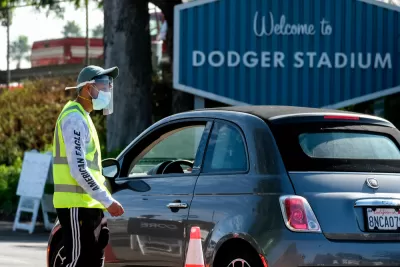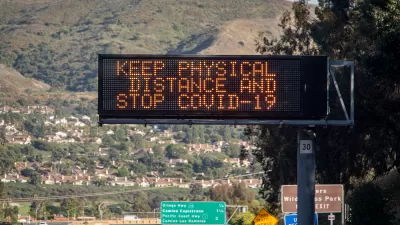Unlike other states that lifted restrictions statewide after coronavirus cases plummeted, California replaced its regional stay-home order with a county-based blueprint, permitting counties to advance based on performance in three health metrics.

President Joe Biden and the Centers for Disease Control and Prevention are warning Americans about the strong possibility of a fourth surge based on rapidly spreading coronavirus variants that are more transmissible than what was experienced in the spring, summer, and fall/winter surges, but some states have dismissed the warning in light of falling infections and hospitalizations.
Like most other states, coronavirus infections in the Golden State have fallen steeply since the second week of January, from a seven-day average of over 44,000 daily new infections on Jan. 14 to just under 4,800 on March 3, according to The New York Times California coronavirus tracker. The state is averaging 12.6 daily new cases per 100,000 people on March 3, the 11th lowest in the nation on the Covid Act Now coronavirus database, compared to the national average of 19 per 100k.
On Jan. 25, Gov. Gavin Newsom lifted the Regional Stay Home order that had imposed the strictest restrictions on a regional basis since the original stay-at-home order issued on March 19, 2020. Once again, outdoor dining and indoor haircuts were permitted, but it also meant that all counties became subject to the state's Blueprint for a Safer Economy.
On Tuesday, "Santa Clara, San Francisco and Napa were among seven California counties that graduated from the state’s most-restrictive reopening stage, paving the way for a return of indoor dining, workouts and other activities that are now outdoor-only," reports Nico Savidge for The Mercury News (source article).
Modoc, Lassen [both rural counties in the northeastern part of the state] and El Dorado counties joined the three from the Bay Area in advancing Tuesday, as did San Luis Obispo, the first in hard-hit southern part of the state to do so.
Last week San Mateo and Marin counties were the first Bay Area counties to move to the less restrictive stage. So far, only tiny Sierra and Alpine counties have made it to the next level, orange.
The metrics
Despite the state's low level of infections compared to the rest of the nation, 87% percent of Californians remain in the lowest tier according to the blueprint—where they were on Jan. 25, because their counties have yet to qualify for a less-restrictive tier based on (scroll down to "Reopening safely for all communities" in the Blueprint):
- Daily new cases (case incidence) per 100,000 people with an adjustment for the number of tests administered
- Test positivity rate
- Health equity quartile
Unlike the regional stay home order which dealt with the greater Bay Area as one planning entity, the Blueprint means the nine counties are on their own. Nora Mishanec of the San Francisco Chronicle reports on the status of the four remaining Bay Area counties:
Alameda, Contra Costa, Solano and Sonoma did not meet the state requirements necessary to emerge from the purple tier, the most restrictive category. Indoor shopping will continue to be permitted in those areas at 25% capacity, but most other business operations will continue to be outdoor only.
But this post ends on a positive note for the entire Bay Area.
Officials in all four purple tier counties were optimistic that they would reach red status in March. Solano and Alameda counties are likely to advance next week, with Contra Costa and Sonoma counties likely to follow by month’s end.
If they do advance, it will be based on the data. California is reopening by the numbers.
Related in Planetizen:
- Texas Lifts Coronavirus Restrictions, Ends Mask Mandate, Despite CDC Warning, March 3, 2021
- Massachusetts Reopens, But is it Too Early? March 3, 2021
- A Fourth Coronavirus Surge is Likely, March 1, 2021
-
California's Stringent Coronavirus Restrictions Worked, February 8, 2021
-
Outdoor Dining and Indoor Haircuts Return to California, January 27, 2021
- California Hospitals Now Operating Under Contingency Care Guidelines, January 4, 2021
FULL STORY: COVID: Three Bay Area counties advance to red tier

Planetizen Federal Action Tracker
A weekly monitor of how Trump’s orders and actions are impacting planners and planning in America.

Congressman Proposes Bill to Rename DC Metro “Trump Train”
The Make Autorail Great Again Act would withhold federal funding to the system until the Washington Metropolitan Area Transit Authority (WMATA), rebrands as the Washington Metropolitan Authority for Greater Access (WMAGA).

The Simple Legislative Tool Transforming Vacant Downtowns
In California, Michigan and Georgia, an easy win is bringing dollars — and delight — back to city centers.

In These Cities, Most New Housing is Under 441 Square Feet
With loosened restrictions on “micro-housing,” tiny units now make up as much as 66% of newly constructed housing.

Albuquerque’s Microtransit: A Planner’s Answer to Food Access Gaps
New microtransit vans in Albuquerque aim to close food access gaps by linking low-income areas to grocery stores, cutting travel times by 30 percent and offering planners a scalable model for equity-focused transit.

This City Will Pay You to Meet Your Neighbors
A North Kansas City grant program offers up to $400 for residents to throw neighborhood block parties.
Urban Design for Planners 1: Software Tools
This six-course series explores essential urban design concepts using open source software and equips planners with the tools they need to participate fully in the urban design process.
Planning for Universal Design
Learn the tools for implementing Universal Design in planning regulations.
Smith Gee Studio
City of Charlotte
City of Camden Redevelopment Agency
City of Astoria
Transportation Research & Education Center (TREC) at Portland State University
US High Speed Rail Association
City of Camden Redevelopment Agency
Municipality of Princeton (NJ)





























